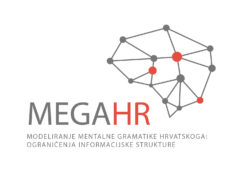The Building Blocks of Croatian Mental Grammar: Constraints of Information Structure (MEGACRO)
The project is funded by the Croatian Science Foundation
Program: Research projects
Project number: HRZZ-IP-2016-06-1210
Principal Investigator: professor Anita Peti-Stantić, PhD
Principal Institution: University of Zagreb, Faculty of Humanities and Social Sciences
Project acronym: MEGAHR/MEGACRO
Scientific area: Humanities
Scientific field: Philology
Project duration: 10.3.2017-9.3.2021. (48 months)
Research group:
professor Anita Peti-Stantić, PhD
professor Gordana Keresteš, PhD
associate professor Maja Anđel, PhD
assistant professor Mateusz-Milan Stanojević, PhD
assistant professor Mirjana Tonković, PhD
assistant professor Nikola Ljubešić, PhD
Jana Willer-Gold, PhD
Dario Lečić, PhD (part of the research group from 2 September 2017 until 10 December 2017)
Jelena Tušek, PhD
Irina Masnikosa, PhD
Vedrana Gnjidić, MA
External associates:
professor emeritus Ray Jackendoff, Tufts University and MIT
professor Petar Milin, PhD, Sheffield University
professor Andrew Nevins, PhD, University College London
professor Motoki Nomachi, PhD, Slavic-Eurasian Research Center of Hokkaido University
Project summary:
The goal of the project The Building Blocks of Croatian Mental Grammar: Constraints of
Information Structure is to determine the building blocks of the information structure of
Croatian mental grammar. Specifically, based on corpus and psycholinguistic research, we will
look into how speakers process morphosyntactic and semantic agreement of concrete and/or
abstract lexical items in coordinated constructions and elliptical conditions, as well as how they
process sentence information structure with regard to complex clitic cluster positioning. Thus,
we will determine a set of necessary, universal and language-specific patterns that represent
the requirements determining the information structure in Croatian, both on the
morphosyntactic and the semantic level. We are predominantly interested in local (linear) and
global (hierarchical) processing constraints within the mental grammar of Croatian. Our
approach will have theoretical consequences for developing a model of language processing, as
well as identifying and correlating global and local building blocks of mental grammar of
Croatian. On the practical level, we seek to improve the productive linguistic competence of
pupils in the education system. This will be operationalized through three main activities: (1)
psycholinguistically establishing a correlation between concreteness and imageability for a set
of high and low frequency lexical and grammatical items (clitics) based on corpus data; (2)
psycholinguistically establishing the relationship between concreteness and agreement (in
gender, ellipsis and clitic cluster positioning); (3) establishing language-specific patterns for
building effective word and grammar webs within the educational system.
Methodological novelty is reflected in connecting a theoretically-based qualitative and
quantitative psycholinguistic research with a corpus study, which will enable the establishment
of a predictive lexical analysis, as well as grammatical patterns in mental grammar.
860 total views, 3 views today
This post is also available in:  Hrvatski (Croatian)
Hrvatski (Croatian)

